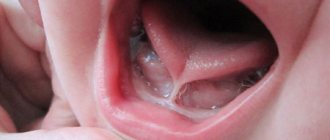Why do you need to trim the bridle?
Any parent wonders whether it is really worth trimming the frenulum under the tongue? Due to its incorrect size, children may have problems with nutrition and development of pronunciation. The frenulum also affects the bite and function of the facial muscles.
It represents a jumper. Necessary for connecting the tongue and lower jaw. Thanks to her, the first one always remains in the right position.
If the frenulum develops with pathology, the functionality of the oral cavity may be impaired. Normally, it should be in the center of the tongue and be from 2.5 to 3 cm long. In babies who are not yet a year old, its size is 8 mm. The most common abnormalities are either that the frenulum is attached to the tip of the tongue or that the length is too short. The latter pathology is called ankyloglossia.
Why is a short frenulum so dangerous? Because of it, the bite is disrupted and improper development of the jaw occurs. You can tell that your baby is small by the fact that he gets tired quickly when he eats, sucks poorly, and cries constantly. If the child clicks when eating, and milk pours out of the mouth, then the frenulum under the tongue needs to be trimmed. Children with this pathology have problems gaining weight. It hurts them to move their tongue. This situation applies to both infants and artificial babies.
At an older age, to check whether the frenulum is in normal condition, you should ask the child to reach the upper palate with his tongue. Deviation will cause bite problems, periodontitis, difficulties with pronunciation, and discomfort during chewing and swallowing. Most often, such a disease is diagnosed by a speech therapist, as parents turn to him because of difficulties in pronouncing letters.
Ankyloglossia must be treated, otherwise the child may, in addition to the above problems, develop an inflammatory disease of the mouth, snoring, problems with the gastrointestinal tract, scoliosis, and nasal speech.
The pathology is transmitted by hereditary factors. If relatives have a similar problem, then most likely the child will be born with an anomaly. Also, this defect is formed during pregnancy if the mother suffered a viral disease, especially in the first and third trimester, toxicosis, exacerbation of chronic illnesses, stress. In addition, abdominal bruise, alcohol, drug use, as well as chemical poisoning in the first three months of fetal development are considered provoking factors. Poor ecology can sometimes cause pathology.
Trimming the frenulum under the tongue in children - why is it necessary?
It would seem that this defect is completely invisible to other people. But in reality the problem can be quite significant for the child. As already mentioned, a short sublingual membrane can cause slurred speech, when a person simply cannot physically pronounce some sounds. This entails problems with socialization, embarrassment, and misunderstanding of words on the part of other people.
A short frenulum can also cause a malocclusion. Correcting it will require more serious financial investments and time than an operation to trim the frenulum.
Due to the inactivity of the tongue, even a normal meal can cause unpleasant and painful sensations. Possible diseases of teeth and gums.
We must not forget that cutting the frenulum under the tongue in children, although it is a low-traumatic operation, still has a number of contraindications, namely:
- various blood diseases;
- viral infections;
- mental illness;
- osteomyelitis;
- oncology.
Before the procedure, it is usually recommended to take a general blood test and check its coagulability, as well as make sure there is no allergy to the anesthetic drug.
At what age should surgery be performed?
Correction of the frenulum of the tongue is carried out at any age. It can be done for small children, schoolchildren and adults. The operation goes quite quickly. Doctors advise doing it to a newborn baby right away. This is due to the fact that it will be easier for the baby to eat, there will be no problems with weight gain, and besides, at this age, surgical intervention is tolerated most painlessly.
For older children, it is quite difficult to have surgery, as you have to use anesthesia. This is due to the fact that it is difficult to convince a one-year-old baby to simply sit still quietly. Therefore, many doctors advise cutting either immediately after birth or when the child is 4-5 years old. Children at this age already tolerate anesthesia well and surgery is not contraindicated for them.
But you need to understand that by this time the baby may have problems with speech, which after the procedure will require a long period to correct and eliminate them.
Why is plastic surgery required?
A short tongue frenulum in a newborn causes a lot of difficulties. Therefore, experts recommend correction at an early age to minimize the consequences. Most often, difficulties arise during breastfeeding:
- It is not possible to attach the baby to the breast correctly.
- The baby has difficulty sucking in milk.
- During feeding, the baby swallows too much air, which subsequently leads to belching and abdominal pain.
- Insufficient consumption of mother's milk leads to the fact that the baby does not grow fast enough.
Which doctor should I see and where is the best place to have surgery?
If there is a suspicion of ankyloglossia, the pediatrician will send the child to a dentist, orthodontist or surgeon. They will either confirm or refute the diagnosis. Whether the tongue frenulum needs to be trimmed will be decided jointly by the orthodontist, speech therapist and surgeon.
There must be good reasons for the operation. These include malocclusion, speech therapy disorders that cannot be corrected by other methods, tooth displacement, and eating problems.
The severity of the anomaly is divided on a 5-point scale. If the deviation is very small, it can be eliminated without surgery using special exercises. The child must be over a year old.
Parents are concerned about the question of where to trim the frenulum of the tongue? The operation is performed in the maternity hospital. If the child is older, the procedure is carried out in dentistry. In case of a severely advanced defect, the operation is performed in surgery in the maxillofacial department.
Types of operations
There are several types of operations during which the shortened hyoid ligament is trimmed:
- Vinogradova's method. During the procedure, tissue is cut from the mucous membrane and sutured to the frenulum.
- Glickman's method. The bridle is cut from the side of the teeth.
- Frenulotomy. The frenulum is trimmed and the edges of the mucosa are sutured.
There are some other types of operations, but they are rarely used. The doctor should select which version of the procedure will be used depending on the severity of the pathology. In some situations, you can do without surgery altogether.
Frenectomy
This procedure is also known under another name: the Glickman method. Clamps are used during the operation. They fix the bridle. Next, the surgeon cuts the skin between the lip and the clamp. Stitches are placed on the edges. If we are talking about cutting in newborns, then for them such an operation is painless and quick.
After 2-3 years, vessels and nerves appear in the frenulum area. It becomes denser and meatier. Therefore, anesthesia must be used and stitches must be applied after the incision.
Symptoms of a short frenulum of the tongue in newborns and older children
The diagnosis of ankyloglossia can be made at any age.
For the first time, the length of the tongue frenulum is checked by a doctor in the maternity hospital. If this pathology is diagnosed, in most cases the frenulum is immediately dissected.
Sometimes ankyloglossia is detected in children at an older age, or in adults when symptoms of this developmental anomaly appear.
Symptoms of a short frenulum of the tongue in infants:
- “Smacking” sounds when feeding;
- Breast biting;
- Large number of feedings on demand;
- The child often abandons the breast and rests, spends a lot of time at the breast;
- Insufficient weight gain;
- Whims at the chest;
- Refusal of breastfeeding.
Symptoms of a short frenulum of the tongue in children after one year and adults:
- Organic type of dyslalia (pronunciation of palatal, hissing and whistling sounds is difficult due to limited mobility of the tongue);
- The inclination of the lower jaw incisors is inward;
- Malocclusion;
- Poor fixation of removable dentures and implants;
- Periodontitis and gum recession.
Ankyloglossia can be diagnosed by a pediatrician
neonatologist, general pediatrician, dentist, surgeon, otolaryngologist.
Parents may suspect that their child has a tongue tie and consult a specialist.
At home, you can ask a child over 2-3 years old to perform small tasks to determine the length of the frenulum.
- Ask your child to stick his tongue out of his mouth. A child with a short frenulum cannot stick out his tongue or the tip of his tongue tends downwards.
- Ask your child to raise his tongue to the roof of his mouth. With ankyloglossia, a dimple forms at the tip of the tongue, and the tongue rises more to the sides. Often the baby cannot run his tongue along the gums at all and touches the tip to the roof of his mouth.
By visually examining the oral cavity, you can estimate the length of the frenulum. Even in a newborn child this figure is more than 8 mm. At the age of 5 years, the length of the frenulum should be more than 17 mm.
Signs of a short frenulum of the tongue are divided into absolute and relative:
- Absolute signs of a short frenulum: difficulty or impossibility of protruding the tongue outside the oral cavity,
inability to lick lips, inability to raise the tongue up to the palate, impaired pronunciation of lingual sounds ([r], [w], [zh], [l], [ch], [sch], [t'], [d']) . - Relative signs: bifurcation of the tip of the tongue when pulled out, formation of a depression on the surface of the tongue when pulled forward, reversal of the central lower incisors.
Depending on the presence of signs of shortening and the length of the frenulum, the degree of limitation of the function of the tongue is determined.
Limitation of tongue mobility:
- Mild degree. The length of the frenulum is more than 15 mm, combined with the presence of relative signs and accompanied by a violation of sound pronunciation.
- Average degree. The length of the frenulum is less than 15 mm, there are absolute signs and/or relative signs.
- Severe degree. The length of the frenulum is 0-10 mm, there are absolute signs of shortening.
What is the pruning procedure like?
If the child is over 2 years old, then he will have to explain why the frenulum under the tongue is cut. This way you can avoid severe stress in your baby. The operation will be performed under general anesthesia. Manipulation time is no more than 5-10 minutes. At this age, there are no nerve endings or blood vessels in the frenulum, so there is no need to worry too much.
If the child is older, then lidocaine or an anesthetic gel is applied to the site of the future incision. Afterwards, the doctor makes an incision using a scalpel or scissors. Seams are not always applied.
Rehabilitation
The rehabilitation period depends entirely on the age at which the tongue frenulum is cut. If the child is less than 9 months old, then after a few hours he can be put to the breast. For older children, rehabilitation lasts about a day. If the operation is performed with a laser, the period is halved.
Immediately after the operation, it becomes easier for newborns to eat; milk helps the wound heal quickly. Breasts immediately begin to gain weight. If the frenulum was cut on a newborn, then he will not have problems with speech. Older children will have to undergo correctional therapy with a speech therapist. Your doctor will tell you what exercises to do.
After the operation, it is forbidden to eat for two hours. For the first three to four days, you should not give your baby anything salty, spicy, sour or hard. It is necessary to avoid eating and drinking too hot. At first, it is better to eat pureed food. Talking too much is prohibited. After eating, you need to rinse your mouth with special antiseptic preparations. These can be infusions of chamomile or calendula, or a solution of Furacilin. If the child is at least five years old, he can be given painkillers if he is in pain. You need to apply sea buckthorn oil or Solcoseryl to the seam. The doctor will definitely tell you what exercises need to be done to support speech, and they should be followed. If necessary, you should regularly visit a speech therapist.
What are the dangers of a short frenulum?
This pathology has the scientific name ankyloglossia, which means “curved tongue.” Most often this phenomenon is observed in boys. An abnormally short frenulum prevents the child from normal control of the tongue, swallowing and even breathing. Usually a pediatric neonatologist helps to detect pathology, but there may be mistakes on the part of some doctors.
A short frenulum prevents the child from controlling his tongue normally, swallowing, and even breathing.
A clear sign of pathology is that the baby has difficulty sucking the breast during feeding, as a result of which he is poorly satiated, behaves restlessly, is capricious, often requires latching to the breast, and does not gain weight.
It is important! In children over three years old, a short frenulum of the upper lip can lead to improper development of the interdental spaces, which are located between the upper incisors, as a result of which they move sharply forward. An anomaly of the lower lip most often leads to improper formation of the bite.
A short frenulum in a newborn is a congenital pathology. The reasons may be different:
- Genetic predisposition - it is not necessary for the baby’s parents to have the same problems. Often the anomaly is inherited from a close relative.
- Pathology can occur during pregnancy, in the first and third trimester. The determining factors are various: drug use during gestation, somatic or infectious diseases, unfavorable natural conditions, abdominal injuries and much more.
- In some cases, an incorrectly developed frenulum of the upper lip is diagnosed in children who already have other congenital anomalies that cause various types of deformities.
Complications after surgery
If a child needs to trim the frenulum of the tongue, then parents should not worry. With proper postoperative treatment, no complications will arise. The surgical intervention is well tolerated by the child, therefore, in addition to the fact that for a while the child will lose the ability to speak for a long time and eat regular food.
If the wound is poorly treated, pain and inflammation may occur. If the child develops a scar, it is necessary to perform a second operation.
Is it possible to stretch the frenulum?
If the child does not pronounce hissing words, it is not necessary to immediately trim the bridle. You can try stretching it. For this, speech therapy massage is performed and exercises are performed.
You should stretch out your tongue and then move it to the sides. You need to reach the tip of it to the lower lip, then to the upper lip. You can click your tongue. To do this, you need to hold it near the sky and lower it down. The tongue should be moved between the cheeks, while the mouth should be closed. Also stretch out your tongue with a tube and smack.
If the child is small, you can often let him lick the spoon. Another way helps: you can drip jam onto your lip, and then ask the child to lick it.
Clinical picture
If such a problem occurs, then the following complications :
- the baby has difficulty sticking out his tongue or is unable to do so;
- the baby cannot extend the tongue, because in this case it takes the shape of an arch;
- the child is unable to raise his tongue to the palate, since in this case its tip bifurcates.
There may be other symptoms that your baby's frenulum is too short. A doctor can make an accurate diagnosis after a thorough examination.
Let's sum it up
It is best to trim the frenulum of the tongue when the child is not yet one year old. What is this connected with? There are no blood vessels or nerves in the area that needs to be cut. Therefore, the baby will not be hurt. Doctors will not have to use anesthesia or painkillers.
If parents did not have the desire or reason for cutting the frenulum at an early age, it is better to wait until 5-6 years. This is due to the fact that children at this age tolerate anesthesia well. The operation is carried out quickly for both infants and adult children. The only difference is the rehabilitation period. In the first case, it takes only a few hours. In the second - several days.
The type of operation the surgeon will perform depends on the indications and reasons. If the child has a mild stage of pathology, it is enough to just make a small incision. Inpatient observation is not required, so you can go home immediately after the procedure. The article above described what is prohibited in the first days after surgery. You need to carefully select your diet; food should not be hard or irritate the mucous membranes (spicy, smoked, etc.).
Is it necessary to trim the frenulum of the tongue? This question worries many parents. Doctors advise doing this either immediately after childbirth, or depending on the situation. Many children with a mild form of the pathology do not experience any discomfort when eating, talking, and so on. In this case, experts recommend waiting until 5-6 years to check whether the child can pronounce words and sounds correctly. If there are any defects, for example, the baby cannot say “r,” then he is sent for surgery. In other cases, you don’t have to worry and just do exercises to stretch the frenulum. They will make the child’s daily life easier and help prevent pathological changes.
You need to understand that the anomaly does not get worse over the years. The frenulum does not shorten, so this will not lead to serious complications if they were not identified before the year. Pronunciation can always be corrected, and surgery is allowed even in adulthood.
What are bridles and why are they needed?
The frenulum is normally capable of lengthening and shortening in the mouth. This is an elastic fold of mucous membrane that stretches from the middle of the tongue to the very base of the gums, approximately in the area of the lower front incisors. Its main purpose is to ensure mobility of the tongue and normal pronunciation of sounds.
The fold may have some deviations, in particular related to its elasticity, length and area of attachment. They are detected in early childhood when a child is examined by a doctor.









